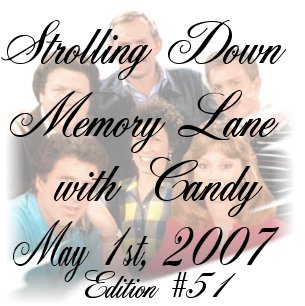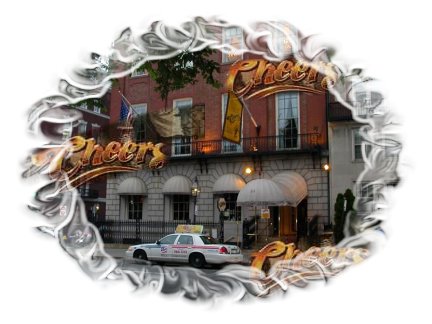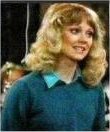
It was as if we could all hang out at this neighborhood bar and be part of the gang. We knew all about Sam and we just knew Carla would insult somebody before the night was over.
So come on along as we take a stroll over to

Cheers, NBC's longest running comedy series, aired from 1982-1993, at 9:00 P.M. Thursdays. The show narrowly escaped cancellation during its first season and took several years to develop a strong following. By 1985, however, Cheers was one of television's most popular shows. It garnered top ten ratings for seven of its eleven seasons and often earned the number one ranking in the weekly Nielsens. The final episode, aired 20 May 1993, received the second-best Nielsen ratings of all-time for an episodic program. Numerous awards complemented Cheers' commercial success and the show boosted the careers of all its stars.
This popular situation comedy is often cited for successfully blending elements of romance and soap opera into the sitcom format. Fans of the show enjoyed its witty dialogue and comic situations, but also followed the twists and turns in the lives of the main characters. Would Sam and Diane get together? Would Rebecca marry Robin? These sorts of plot questions strung together episodes and whole seasons, which often ended with summer cliffhangers, a rare device for television comedy.
 The show was set at Cheers, the Boston bar "where everybody knows your name." Bar owner Sam Malone (Ted Danson), a former Red Sox pitcher and an irascible womanizer, served up beers and traded one-liners with regular customers Cliff (John Ratzenberger) and Norm (George Wendt). Carla (Rhea Perlman), a feisty waitress with a weakness for hockey players, kept the men in check with her ascerbic comments. Bartender "Coach" (Nicholas Colasanto) was the slow-witted and ironically funny straight man of the ensemble cast. When Colasanto passed away in 1985, Woody Harrelson joined the cast as Woody, a young bartender who took slow-wittedness to new heights.
The show was set at Cheers, the Boston bar "where everybody knows your name." Bar owner Sam Malone (Ted Danson), a former Red Sox pitcher and an irascible womanizer, served up beers and traded one-liners with regular customers Cliff (John Ratzenberger) and Norm (George Wendt). Carla (Rhea Perlman), a feisty waitress with a weakness for hockey players, kept the men in check with her ascerbic comments. Bartender "Coach" (Nicholas Colasanto) was the slow-witted and ironically funny straight man of the ensemble cast. When Colasanto passed away in 1985, Woody Harrelson joined the cast as Woody, a young bartender who took slow-wittedness to new heights.
 Sam's on-again, off-again romance with cocktail waitress Diane (Shelly Long) exemplified the show's serial-comedy mix. In the first season, Diane despised Sam and constantly rejected his come-ons. In the second season, she started a torrid affair with him. They broke it off in the third season, and Diane took up with a neurotic psychiatrist, Frasier Crane (Kelsey Grammer). Diane almost went back to Sam after the fourth season, but then rejected his marriage proposal. The ongoing romantic tension allowed Sam and Diane to develop as characters. Flashbacks and references to past episodes gave the show a sense of continuous history, like an evening soap. Over the years, other characters developed their own plot lines. Rebecca (Kirstie Alley), who replaced Diane when actress Shelly Long left the show in 1987, pursued a futile romance with Robin, a corporate raider who briefly owned the bar. Woody dated Kelly (Jackie Swanson), a wealthy socialite who matched him in naiveté. Frasier married Lillith (Bebe Neuwirth), an ice-cold psychiatrist who matched him in neurosis. Only Cliff and Norm remained essentially static, holding down the bar with their mutual put-downs.
Sam's on-again, off-again romance with cocktail waitress Diane (Shelly Long) exemplified the show's serial-comedy mix. In the first season, Diane despised Sam and constantly rejected his come-ons. In the second season, she started a torrid affair with him. They broke it off in the third season, and Diane took up with a neurotic psychiatrist, Frasier Crane (Kelsey Grammer). Diane almost went back to Sam after the fourth season, but then rejected his marriage proposal. The ongoing romantic tension allowed Sam and Diane to develop as characters. Flashbacks and references to past episodes gave the show a sense of continuous history, like an evening soap. Over the years, other characters developed their own plot lines. Rebecca (Kirstie Alley), who replaced Diane when actress Shelly Long left the show in 1987, pursued a futile romance with Robin, a corporate raider who briefly owned the bar. Woody dated Kelly (Jackie Swanson), a wealthy socialite who matched him in naiveté. Frasier married Lillith (Bebe Neuwirth), an ice-cold psychiatrist who matched him in neurosis. Only Cliff and Norm remained essentially static, holding down the bar with their mutual put-downs.
 The creators of Cheers, Glen Charles, James Burrows, and Les Charles, previously worked on various MTM sitcoms, such as The Mary Tyler Moore Show, Phyllis, and The Bob Newhart Show. Like Taxi, another of their creations, Cheers inherited the MTM emphasis on character development. Upscale audiences appreciated this emphasis--and advertisers appreciated the upscale audiences. Fans of Cheers especially enjoyed the show's irreverent attitudes toward social conventions. Cheers was not politically correct: the main character was a womanizer; Rebecca pretended to be a career woman but really just wanted a rich husband; and the collegial atmosphere centered around drinking. Though several of the characters were working-class, the show completely avoided social issues. And Cheers never preached to its audience on any subjects whatsoever. Even the poignant moments of personal drama that quieted the set from time to time were quickly counter-balanced by sardonic one-liners before any serious message could take hold.
The creators of Cheers, Glen Charles, James Burrows, and Les Charles, previously worked on various MTM sitcoms, such as The Mary Tyler Moore Show, Phyllis, and The Bob Newhart Show. Like Taxi, another of their creations, Cheers inherited the MTM emphasis on character development. Upscale audiences appreciated this emphasis--and advertisers appreciated the upscale audiences. Fans of Cheers especially enjoyed the show's irreverent attitudes toward social conventions. Cheers was not politically correct: the main character was a womanizer; Rebecca pretended to be a career woman but really just wanted a rich husband; and the collegial atmosphere centered around drinking. Though several of the characters were working-class, the show completely avoided social issues. And Cheers never preached to its audience on any subjects whatsoever. Even the poignant moments of personal drama that quieted the set from time to time were quickly counter-balanced by sardonic one-liners before any serious message could take hold.
 In 1993 Paramount announced that Cheers would go off the air. The show was still highly rated, but production costs had soared to record numbers--$65 million for the 1991-92 season. Star Ted Danson, reportedly in on the decision to cancel, was earning $450,000 per episode. The network orchestrated a rousing finale, which garnered a 45.5 rating and a 64 audience share. On the evening of the finale, many local newscasts aired segments from bars, where fans saluted Cheers from an appropriate setting. In 1994, Kelsey Grammer launched a spin-off, Frasier, and George Wendt tried his own series, The George Wendt Show. Woody Harrelson landed starring roles in Hollywood, following in the footsteps of his Cheers co-stars Alley and Danson.
In 1993 Paramount announced that Cheers would go off the air. The show was still highly rated, but production costs had soared to record numbers--$65 million for the 1991-92 season. Star Ted Danson, reportedly in on the decision to cancel, was earning $450,000 per episode. The network orchestrated a rousing finale, which garnered a 45.5 rating and a 64 audience share. On the evening of the finale, many local newscasts aired segments from bars, where fans saluted Cheers from an appropriate setting. In 1994, Kelsey Grammer launched a spin-off, Frasier, and George Wendt tried his own series, The George Wendt Show. Woody Harrelson landed starring roles in Hollywood, following in the footsteps of his Cheers co-stars Alley and Danson.
Over the years Cheers received 26 Emmy Awards and a record 111 Emmy nominations. In 1995 it rivaled M*A*S*H and Roseanne on the rerun circuit and showed all signs of continuing to be a major hit in syndication. As an inheritor of the MTM character-comedy tradition, Cheers pushed the "serialization" of sitcoms to new levels and was one of the most successful shows from the 1980s.
Thank goodness for re-runs so we can still get in on the fun and pretend we don't know what's going to happen next even though we've seen these episodes over and over. To think a whole new generation is seeing Cheers for the first time and loving it just like we did, now that's worth toasting to...
